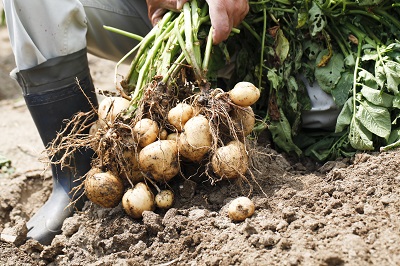Premiere Seed Potatoes
Premiere is popular due to its good all round disease resistance to blight, common scab, powdery scab, spraing and it is also resistant to Potato Cyst Nematode. This potato seed is a first early variety..
| Yearly Average Bag Counts | | Count per bag depends on the previous growing season and size of the tuber grade out, below we list the average number across a count of 10 bags of this variety. | | 2020: | TBC | | | Premiere Seed Potatoes Fact File | | Year of Breeding: | 1979 | | Maturity: | First Early | | General Comments: | Good reliable performer! | | Cooking Comments: | After cooking, the flesh has the capacity to crumble, but if left to cool it will firm up and slice easily. The skin stays intact after cooking. | | Frost Hardy: | No | | Tuber: | Yellow skin and yellow flesh. Firm, slightly dry texture, Oval. | | Blight Resistance | - | | Scab Resistance | - | | Eelworm (PCN) Resistance | Resistant | |
How To Grow Premiere Potatoes
Soil preparation for first early seed potatoes
 First, try and order your early seed potatoes as soon as they are available to get the varieties to want to grow, which in most cases is around mid-January and early February onwards. Quality seed potatoes should be firm, and spring back into shape when lightly squeezed, as opposed to being soft and mushy. Potatoes can be grown is a wide variety of soil types but light, sandy soils and very heavy clay soil would perform better with the addition of generous amounts of organic matter or well-rotted compost. This would help to give the soil structure and aid drainage. An open sunny position is best for all potatoes.
First, try and order your early seed potatoes as soon as they are available to get the varieties to want to grow, which in most cases is around mid-January and early February onwards. Quality seed potatoes should be firm, and spring back into shape when lightly squeezed, as opposed to being soft and mushy. Potatoes can be grown is a wide variety of soil types but light, sandy soils and very heavy clay soil would perform better with the addition of generous amounts of organic matter or well-rotted compost. This would help to give the soil structure and aid drainage. An open sunny position is best for all potatoes.
If the soil is prepared in late autumn, it should be ready for planting seed potatoes in the following early to late March. It is advisable to not plant seed potatoes in ground that has been used to grow the same crop for 2 years or more as this would increase the possibility of disease. If you intend to grow in containers then the same rules and preparations apply. In all cases early seed potatoes will benefit from chitting. This is the process of encouraging shoots to sprout, by placing the potatoes in a light, cool place prior to planting.
Planting first early seed potatoes in beds
Select a suitable day from mid-March to mid-April, which is dry and clear of any frost. If growing in beds then lightly rake the prepared soil to a workable tilth. Next, dig a trench around 10cm deep and place the seed potatoes at 30cm apart. Ensure the potatoes have the rose end facing upwards. This will be the end with most shoots. Once lined out into the trench cover with soil and lightly firm. A light application of potato fertiliser can be spread over the top of the trench. There is no need to water the trenches at this point but water may be required should the following months be warm and dry.
If planting more than one row then space rows at 60cm apart. It’s a good idea to cover the trenches with a polythene cloche tunnel for the first few weeks, which will encourage the seed potatoes to grow quicker and could reduce the growing and harvesting time by as much as 2 weeks. Remove the tunnels when the shoots are about 10-15cm high.
Growing first early seed potatoes in containers
First early potatoes can be successfully grown in a variety of containers but ideally they need to have a capacity of at least 30 litres. Barrels, bins, water-butts and oil drums all make perfectly large containers with lots of room for the new tubers to grow. Alternatively, any large clay, plastic or wooden container will suffice. In all cases drainage holes must be either present or drilled so that excess water can drain away freely. If the containers become water logged then the potatoes will very likely be damaged by rot.
Fill the container with soil to within two thirds capacity and plant the seed potatoes with the rose end facing upwards. Then cover the seed potatoes with 100cm of soil and firm. A light dressing of potato fertiliser can be added at this time and a light watering may be required if the soil is dry. Cover the container with clear polythene and wait until the green shoots appear. Once the shoots are about 75cm high remove the polythene and water lightly. Soil in containers can dry out very quickly in warm weather so ensure plants are kept well watered.
General aftercare
 There are two routine tasks required when growing potatoes. The first one is to keep plants well watered, especially during dry periods. This is important because the young potato tubers need a fair amount of water in order to grow properly. The second routine task is to “earth up” the young shoots. You do this by drawing soil up against the shoots, using a hoe for plants in beds, and by adding soil by hand to the containers as the plants grow.
There are two routine tasks required when growing potatoes. The first one is to keep plants well watered, especially during dry periods. This is important because the young potato tubers need a fair amount of water in order to grow properly. The second routine task is to “earth up” the young shoots. You do this by drawing soil up against the shoots, using a hoe for plants in beds, and by adding soil by hand to the containers as the plants grow.
The reasons for this are two-fold. The first one is to protect the delicate shoots from frost, and the other is to ensure the tubers, which grow closest to the soil surface are not exposed to light, which will make them green and inedible.
Pests and diseases
The main problem associated with potatoes is blight. This can be serious during warm months from June onwards, and if detected then spray plants with a proprietary fungicide. Scab is also a common problem with tubers grown on alkaline soil but rarely affects the quality of the potato. To avoid this condition, soil can be improved by the addition of organic matter. Slugs can be a real problem but “earthing up” can help protect stems and leaves from attack. Black leg and eel worm are other possible problems, with the latter being the most serious. If eel worm is detected then avoid growing potatoes on the infected plot.
Harvesting and storage
First early potatoes can be harvested after 10-12 weeks up to about 14 weeks after planting. Lift the plants and remove the tubers. Leave them to dry for a few hours before storing in hessian or paper sacks. It is not advisable to use polythene sacks as the potatoes will sweat and rot. Keep in a well ventilated, dry and frost free place.